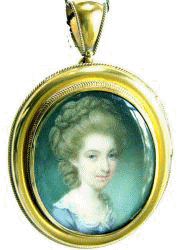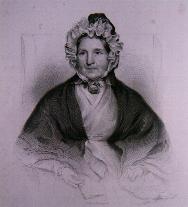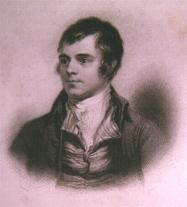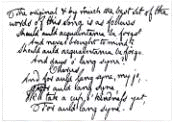


EACHDRAIDH DUNLOP
FOOTSTEPS OF OUR CLAN
HERE BE HISTORIES OF OUR NAMESAKES
READ…AND WALK WITH THEM THROUGH TIME…
How Rabbie Burns became involved with Clan Dunlop,
And how the most famous Holiday song is forever entwined with our Name.



Frances Rabbie
In 1745 John Dunlop of Dunlop, 19th of that Ilk, had been deputized by the gentlemen of Ayr, together with Sir Thomas Wallace of Craigie, to assist the Duke of Cumberland against the Young Pretender, Bonnie Prince Charlie. After Charlie’s defeat at Culloden, John and Sir Thomas returned to Ayr fast friends, and were soon to be related through marriage. Sir Thomas’s eldest daughter was born Frances Anna Wallace in 1730…descendant of Sir Richard Wallace, cousin to the Braveheart: Sir William Wallace himself. Thomas encouraged his daughter toward John Dunlop and the two wed in 1748.
Frances loved John, and gave him six daughters and five sons. The eldest son, Thomas Dunlop, succeeded his maternal grandfather as Laird of Craigie and assumed the name and arms of Wallace. Frances also grew to love the Dunlop House (At that time the 1599 house built by James Dunlop, since replaced by the Hamilton designed 1834 Dunlop House.
Dark times came in 1785. Early in the year insurmountable debt and some mismanagement would force her son to sell her treasured Craigie, home of her youth. Then in June, her beloved John passed away. With this second heavy blow, she fell into a deep state of depression. A good friend, Betty M’Adam, gave Frances a copy of “Cotter’s Saturday Night” to read trying to cheer her out of her dark mood.
The publication contained poems by Robert Burns, a young poet. Frances was so moved by these poems that she wrote to the author, requesting six copies of his small book of poems referenced in Cotter’s. Robert’s brother Gilbert Burns recorded that: ”Mrs. Dunlop sent off a person express to Mossgeil, distant fifteen or sixteen miles, with a very obliging letter to my brother, desiring him to send her half a dozen copies of his “Poems”, if he had them to spare, and begging he would do her the pleasure of calling at Dunlop House as soon as convenient. This was the beginning of a correspondence, which ended only with the poet’s life.”
Burns replied to Mrs. Dunlop’s note on the 15th of November 1786 in an autobiographical vein, adding: “I have only been able to send you 5 copies: they are all I command. I am thinking to go to Edinburgh in a week or two at farthest, to throw off a second impression of my book; but on my return, I shall certainly do myself the honor to wait on you.” Burns visited Mrs. Dunlop at least five times- June 1787; February 1788 for two days; May 1789 for two days; 21rst June 1791; and December 1792, when he stayed at Dunlop House for 4 days.
Mrs. Dunlop wanted to establish herself as the “Approver” of his writings. He never named her to that position, so she named herself. She gossiped about him, she criticized him. She introduced his writings to Dr. Moore and urged Burns to write Dr. Moore himself, which he finally did to the great enhancement of his career. Burns wrote more letters to Frances Dunlop than to any other correspondent. Her family troubles aroused Burns’s deepest sympathies.
He routinely wrote her about his works, asking her reaction or even reacting to her letters with verse. On the 17th December 1788, Burns said in a letter to Mrs. Dunlop: “Your meeting which you so well describe with your old schoolfellow and friend was truly interesting. Out upon the ways of the world! They spoil these ‘social offsprings of the hear.’ Two veterans of the ‘men of the world’ would have met with little more heart-workings than two old hacks worn out on the road. Apropos, is not the Scotch phrase Auld Lang Syne exceedingly expressive? There is an old song and tune which often thrilled my through my soul. You know I am an enthusiast in the old Scotch songs. I shall give you the verses on the other sheet. …Light be the turf on the breast of the heaven-inspired poet who composed this glorious fragment! There is more fire of native genius in it than in half a dozen of modern English Bacchanalians.” The song on the other sheet was Burns’s first written version of “Auld Lang Syne.”(See photo) While Burns readily admits that he did not originate the tune and some verse, his is the version now sung every New Years Eve and Burns’ night by millions of English-speaking people around the world!

Auld Lang Syne
Should auld acquaintance be forgot, Chorus:
And never brought to mind? For auld lang syne, my jo, (now :my dear)
Should auld acquaintance be forgot, For auld lang syne
And days o’ lang syne! We’ll tak a cup o’ kindness yet
For auld lang syne!
We twa hae run about the braes,
And pu’d the gowans fine,
But we’ve wander’d mony a weary foot “Auld Lang Syne” translates to “Times Long Gone”
Sin auld lang syne. Literally as “Olde Long Tyme”
We twa hae paidl’t in the burn
Frae morning sun till dine,
But seas between us braid hae roar’d
Sin auld lang syne.
And there’s a hand, my trusty fiere,
And gie’s a hand o’ thine,
And we’ll tak a right guid willie-waught
For auld lang syne!
And surely ye’ll be your pint’ stoup,
And surely I’ll be mine!
And we’ll tak a cup o’ kindness yet
For auld lang syne!
Because of differing political views regarding the French Revolution, Frances ignored Burns’s letters during 1795 and January 1796. Burns, however had caught a fever, and was ill for several weeks. He had taken a turn for the worse and wrote her one last time, according to his brother Gilbert: “the last use he made of his pen was writing a short letter to this lady a few days before his death.” Burns wrote: “Madam. I have written you so often without rec.g any answer, that I would not trouble you again but for the circumstances in which I am. An illness which has long hung about me in all probability will speedily send me beyond that bourne whence no traveller returns. Your friendship which for many years you honored me was a friendship dearest to my soul. Your conversation & especially your correspondence were at once highly entertaining & instructive. With what pleasure did I use to break the seal! The remembrance yet adds one pulse more to my poor palpitating heart! ‘Farewell!!!” Her letter in response was the last thing the poet read on his deathbed.
The Footsteps of our Clan tread lightly across the last words and the works of Robert Burns.
“Merito”

PS: Important points to remember for Burns suppers:
-Robert Burns corresponded with Frances Dunlop more than with anyone.
-He visited her many times at Dunlop House and shared his verse before publishing.
-He wrote the first version of his “Auld Lang Syne” to her in a letter.
-His son, born on 18 August 1789, was named Francis Wallace Burns, after her.
-One of his last letters was to her, the other to his wife.
Sources: http://www.robertburns.org
The “Cottage Museum Monument”
Published by the Burns Monument Trust and Jerrold Publishing 1999
“Dirt and Deity” A Life of Robert Burns. McIntyre. Flamingo, London.1996
